If you are looking for a long-lasting, hydrating lip balm made with natural ingredients, you are going to love this DIY lip balm recipe.
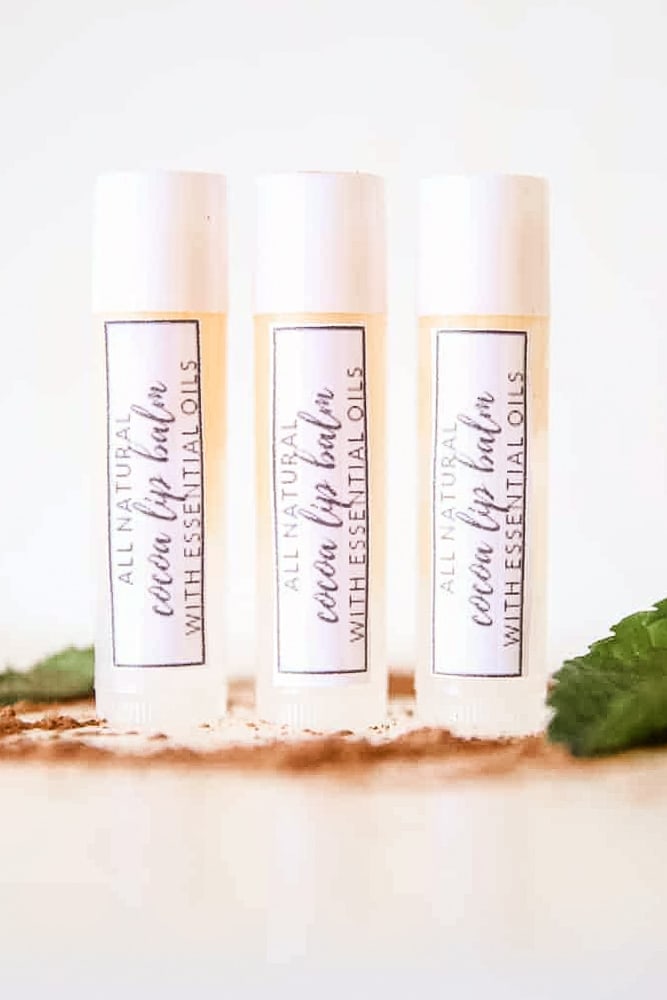
I hope you love saving money and using natural, eco-friendly ingredients in all your DIYs; I know I do!
I’ve been making this recipe every winter for years to help with my dry lips. It’s such an easy recipe to make and is extremely cost-efficient!
Like many of my DIYs, I use many of the same ingredients as my lip gloss and lipstick recipes. The result is a lip balm recipe that is perfect for chapped lips.
This post contains affiliate links, which means I make a small commission at no extra cost to you. Get my full disclosure HERE.
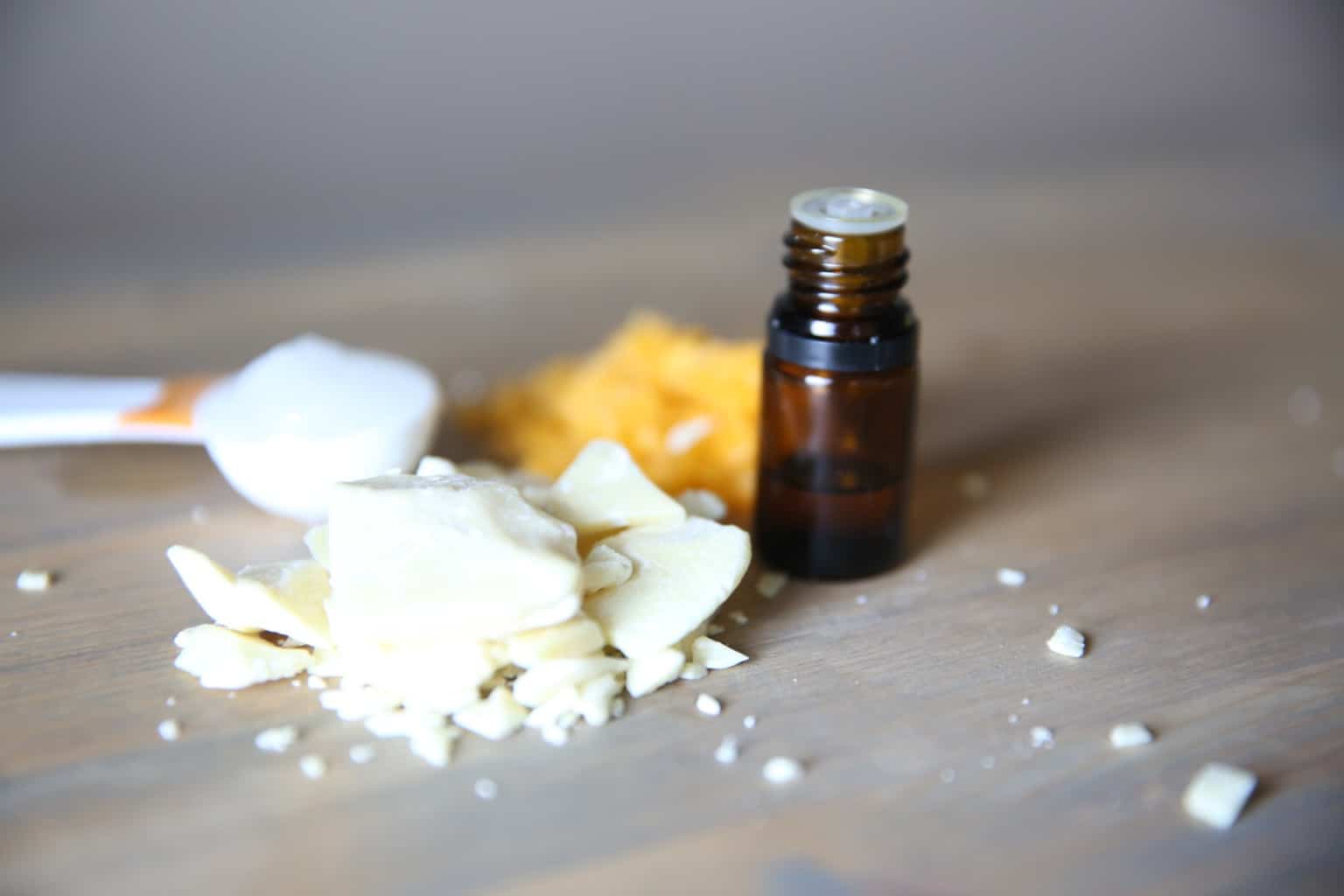
How to make lip balm
Lip balm ingredients
- 2 tablespoons beeswax
- 2 tablespoons cocoa butter
- 2 tablespoons coconut oil
- 10 drops of essential oils (I’ll share my favorites below)
- Lip balm tubes (this recipe will fill about 12 tubes)
*More information on these ingredients can be found below in this post.
Lip balm recipe
Step 1: Place all the ingredients (except essential oils) in a double boiler. Don’t worry if you don’t have a double boiler; I simply use a glass Pyrex bowl over a small saucepan of water. (see image below)
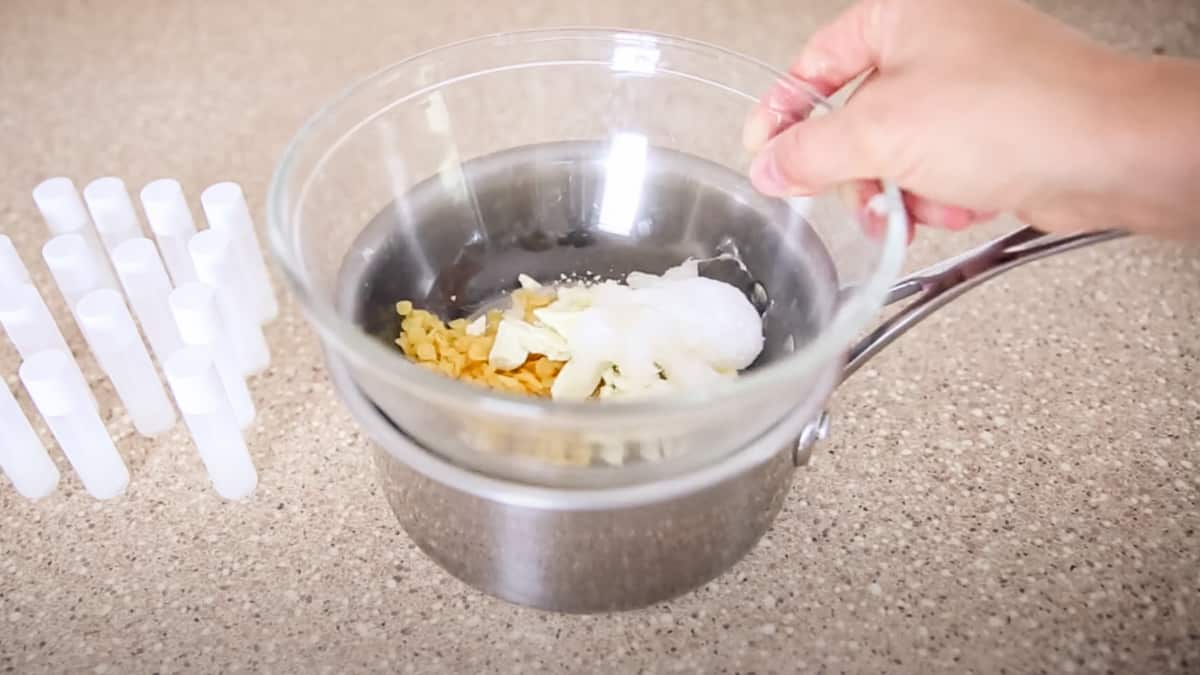
Step 2: Melt all the ingredients together, stirring often.
Pro tip: Use beeswax pellets instead of block beeswax to speed up the melting process.
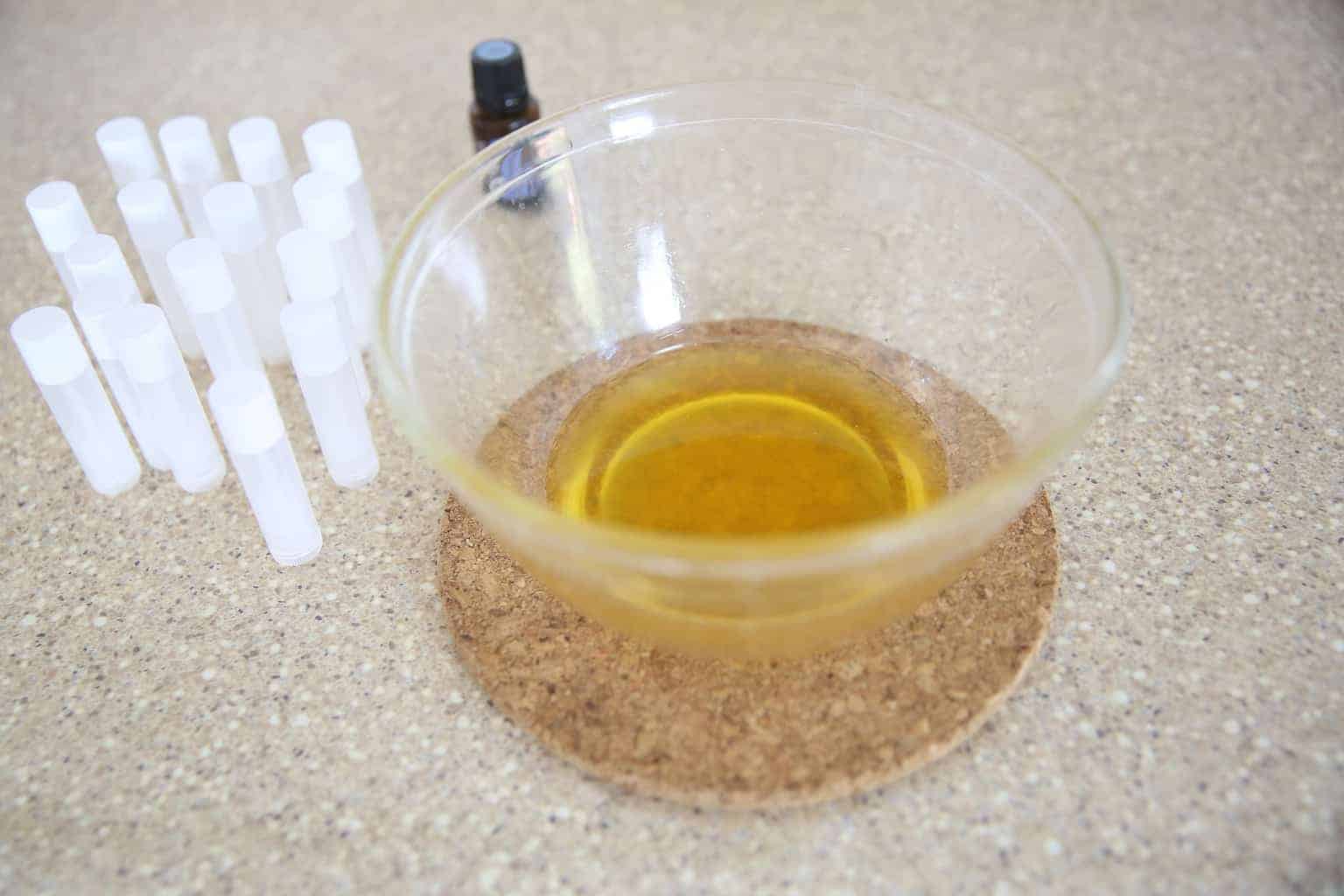
Step 3: Once all the ingredients are melted, remove from the heat, add essential oils if used, and mix well. Work fast, as the mixture will harden quickly after being removed from the heat.
Note: You’ll want to add the drops of essential oils during the cooling process so they don’t lose any of their properties.
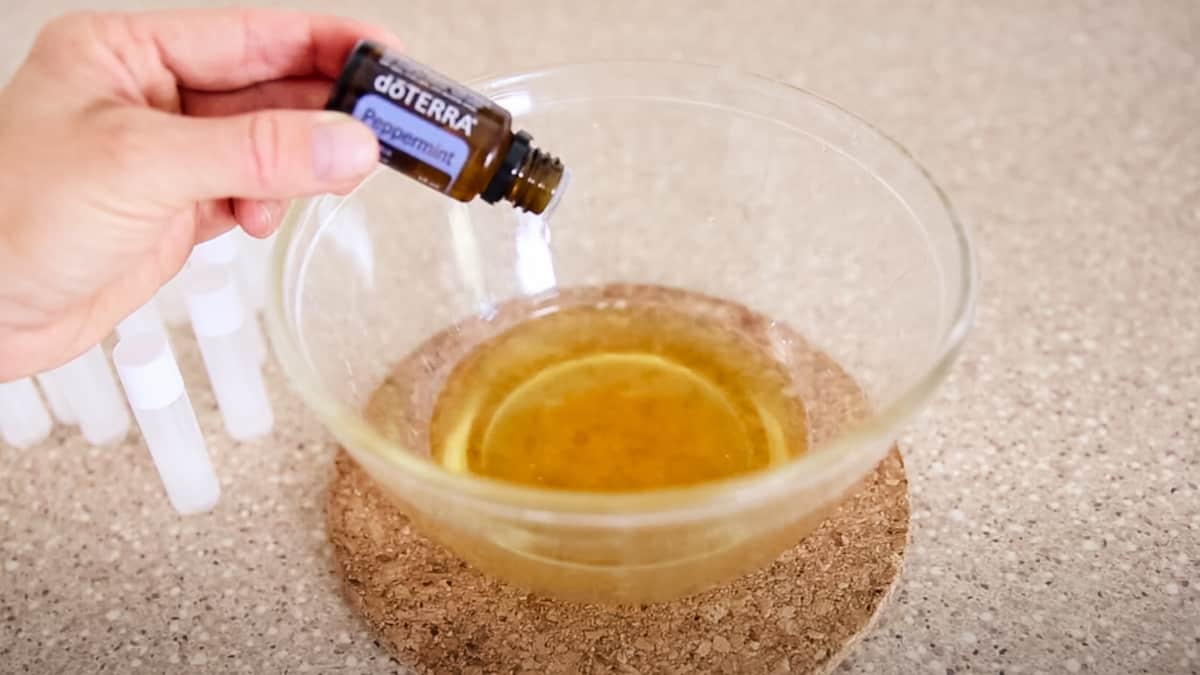
Step 4: Fill the lip balm containers using a small funnel, pipette, or old medicine dropper. Then, just let them cool before securing the caps.
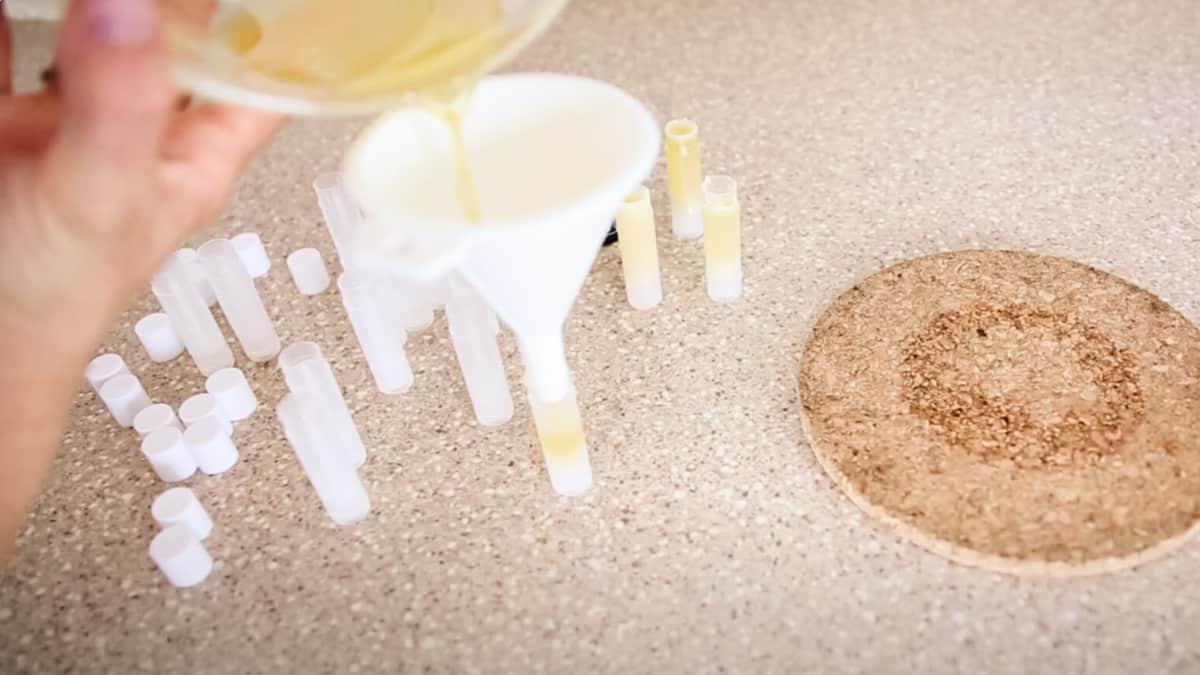
Top tips
- Apply this lip balm directly to the lips like you would with any other lip balm or chapstick.
- You may want to perform a patch test first before using this or any new product for the first time. Apply a little of the balm onto your forearm and check for any adverse reactions after 24 hours.
- Let tubes sit at room temperature for a few hours until cooled and completely hardened before capping them—store extras in a cool, dry place.
- In the case of extremely chapped or dry, flaky lips, exfoliate first with a lip exfoliating scrub.
- Additionally, you can use a lip balm before or after a face mist to hydrate the whole face.
- After making this simple recipe, don’t let it get lost in the array of storage tins, containers, and tubes. Print off a free lip balm label in my online resource library.
Substitutions
Each of the ingredients can be easily substituted to satisfy your specific wants.
- Beeswax can be substituted equally for soy wax with minimal change to the finished lip balm. It’s a great option if you are looking for a vegan lip balm.
- Cocoa butter shares many similar properties with shea butter and mango butter. As a result, substitute or mix and match any of these three butters.
- Essential oils: as long as they are pure, with no added fillers, they make a great addition to this lip balm recipe. You’ll find a list of gentle oils to add below.
You can also learn more about the ingredients in this recipe below.
One thing regarding the ingredients
You’ll notice that almost all the ingredients are solid in this recipe. I have made it using a small amount of carrier oils such as sweet almond oil, olive oil, or castor oil for more of a moisturizing effect.
While the balm will not be as hard, adding half a teaspoon of one of the carrier oils mentioned will still make a lovely lip balm.
My favorite carrier oil was the sweet almond, and the least was definitely the olive oil. So, pick your favorite oils and go from there! You can even add a few drops of vitamin E if you wish.
What ingredients are we using in this lip balm?
Beeswax: This main ingredient is essential in fighting against chapped lips or skin. In addition, it forms a protective wall by sealing moisture in the skin without clogging up the pores.
You can make a lip balm without beeswax, but the balm will not provide the same protection or texture that it would otherwise have with beeswax.
Cocoa Butter: Cocoa butter is the fat that comes from cocoa beans, and it smells absolutely delicious, in my opinion. This might be why my kids like to eat their lip balm!
Don’t worry; cocoa butter is edible! Cocoa butter naturally moisturizes the skin and heals dry, chapped skin.
Coconut Oil: The hype around coconut oil these days is for a good reason. You can use it in the kitchen, on your skin, in your hair, and the list goes on. Coconut oil is an all-around excellent moisturizer for your skin and lips.
Essential Oils: Several essential oils can do wonders for skin imperfections. I like using peppermint oil in my chapstick because of the cooling effect it has.
Peppermint is very soothing for dry, chapped lips. Lavender is another one of my personal favorites, partly because it is very gentle on sensitive skin, such as the lips, but also because it smells incredible with cocoa butter.
Lip balm storage options
Use old lip balm or chapstick tubes when possible. If those are unavailable, empty tubes are pretty cheap and are reusable.
I bought a set of chapstick tubes years ago, and I am still reusing them. However, if you prefer, a small tin or container works well for storing your natural lip balm.
Plus, it is easier to fill a large container than the smaller tubes.
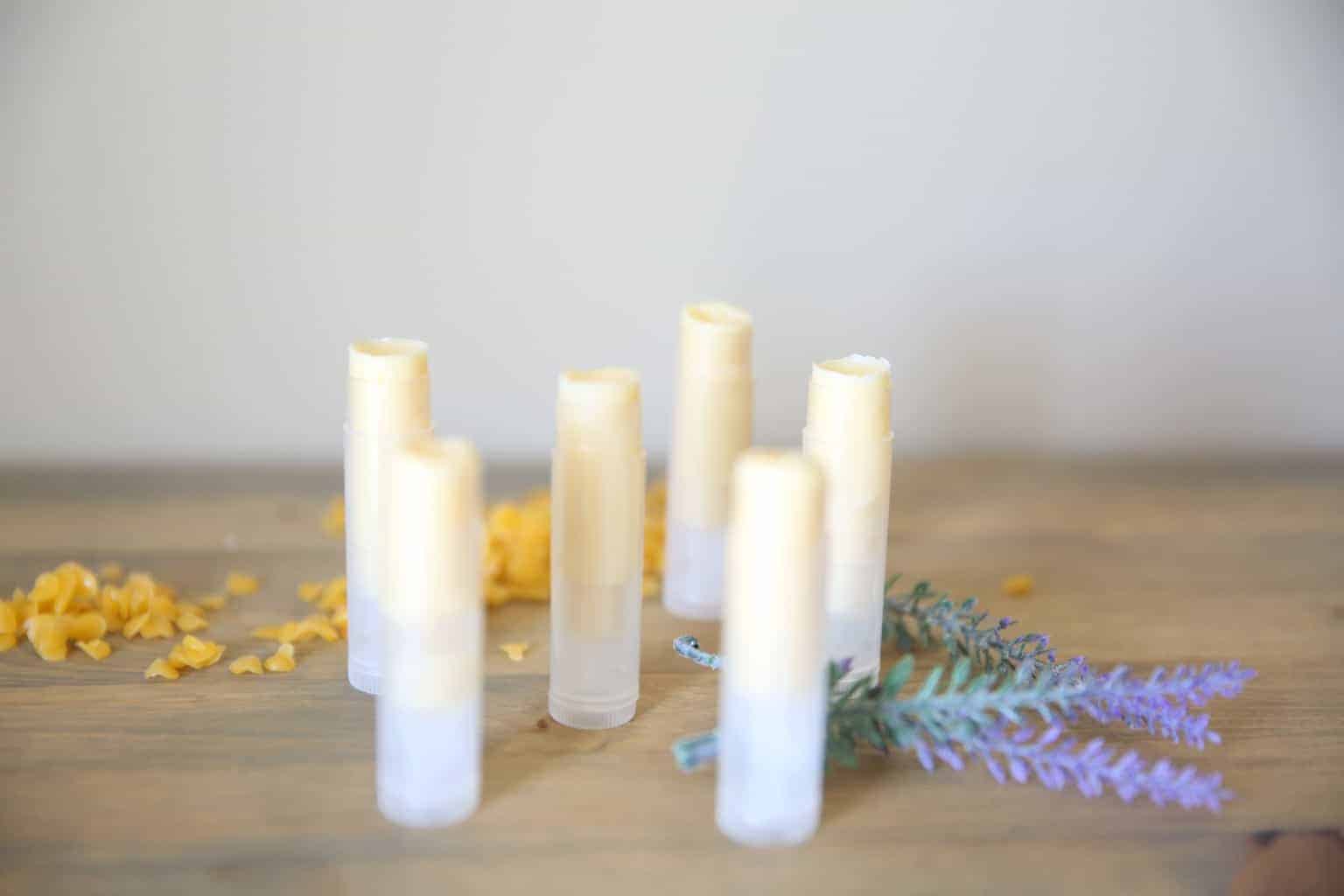
How long does lip balm last?
This lip balm recipe has a shelf life of up to two years. Trust me, they’ll be long gone by then.
Beeswax essentially has no expiration.
While some essential oils may last forever, you can generally expect 2-5 years, after which they will begin to lose some of their potency. You can learn more about that here.
The two ingredients that do have a shelf-life are cocoa butter and coconut oil. Both of which will last at least two years if stored in a cool, dry place.
Essential oils for lip balm
Depending on your preferred flavor and scent, you can use several essential oils in your lip balm. For example, use mint essential oils to cool and soothe chapped lips.
*WARNING: If you use any citrus essential oils in your lip balm, do not apply them to the lips if you’re going to be in direct sunlight. Citrus essential oils can cause a phototoxic reaction, typically resulting in an exaggerated sunburn.
- Lavender: Great for the skin and smells fantastic.
- Peppermint: The cooling effect of peppermint feels really good on chapped lips.
- Spearmint: This has the same cooling effect as peppermint with a milder, sweeter scent.
- Roman Chamomile: I love this delicate floral oil scent, and it has many benefits for the skin.
- *Wild Orange: Orange and chocolate…need I say more?
- *Lemon: This oil is very uplifting, refreshing, and cleansing, making it perfect for your lip balm.
- Rose: Rose oil is amazing for any skin imperfection, and of course, it smells lovely.
- Frankincense: Known for its extensive benefits, frankincense has been used in cosmetics for millenniums.
- Rosemary: Pairs beautifully with lavender and the other ingredients in the lip balm.
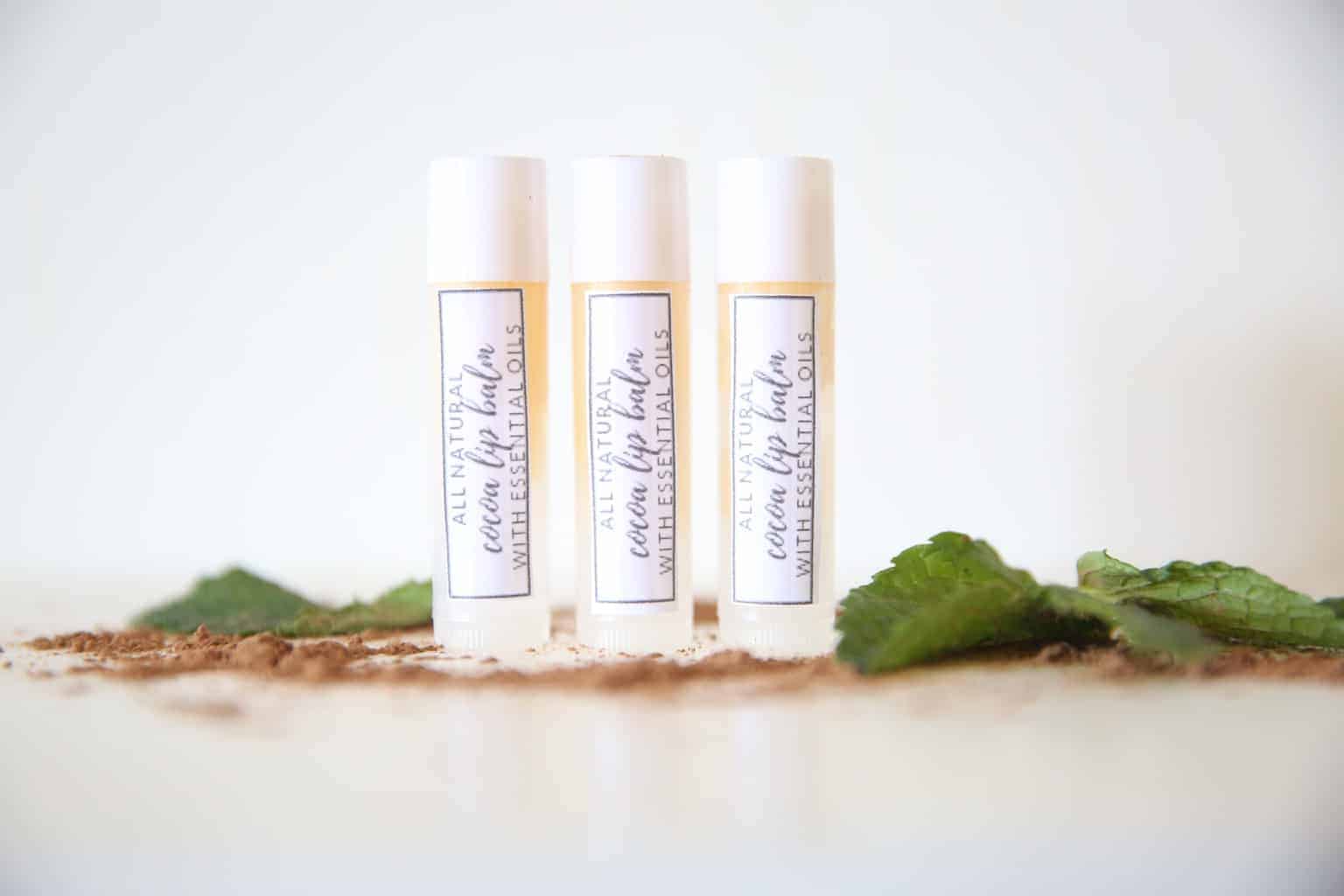
Why homemade lip balm
Making your own beauty products is a great way to ensure the products on your body are natural, pure, and free of artificial or synthetic ingredients.
In addition to the above, making your own lip balm, beauty products, etc., allows you the opportunity to customize each recipe to suit your specific wants and needs.
I made a batch last winter for some homemade gifts and ended up scenting them with vanilla. Let’s just say they went over quite well!
Ingredients found in many conventional store-bought lip balms
Petroleum Jelly: Petroleum jelly can make your skin or lips feel moisturized and hydrated. However, studies have shown it to be a carcinogen, a toxic ingredient, and is not recommended for use on the lips.
Parabens: Parabens are a group of compounds used as a preservative in most cosmetic and personal products. They mimic estrogen and cause hormone imbalances. Parabens are found in 99% of breast cancer tumors!
Fragrance: Fragrances can cause allergic reactions, contain hormone disturbers and carcinogens, and have been linked to damage sperm.
Lanolin: Lanolin is a waxy substance that coats a sheep’s fur, keeping it moist and protecting its skin. If you aren’t buying organic, this ingredient may be loaded with pesticides and chemicals that are sprayed on the sheep’s fur to protect them against bugs.
Artificial Dyes: Artificial dyes are known to cause allergic reactions. They have been linked to cancer tumors and hyperactivity in children.
Lip balm vs chapstick
Both lip balm and chapstick are interchangeable, with chapstick being a form of lip balm. Many may associate lip balm with providing protection for the lips while using chapstick more as a moisturizer.
With a number of different lip balm variations, you are sure to find one to fit your specific needs.
Related: how to make a lip oil
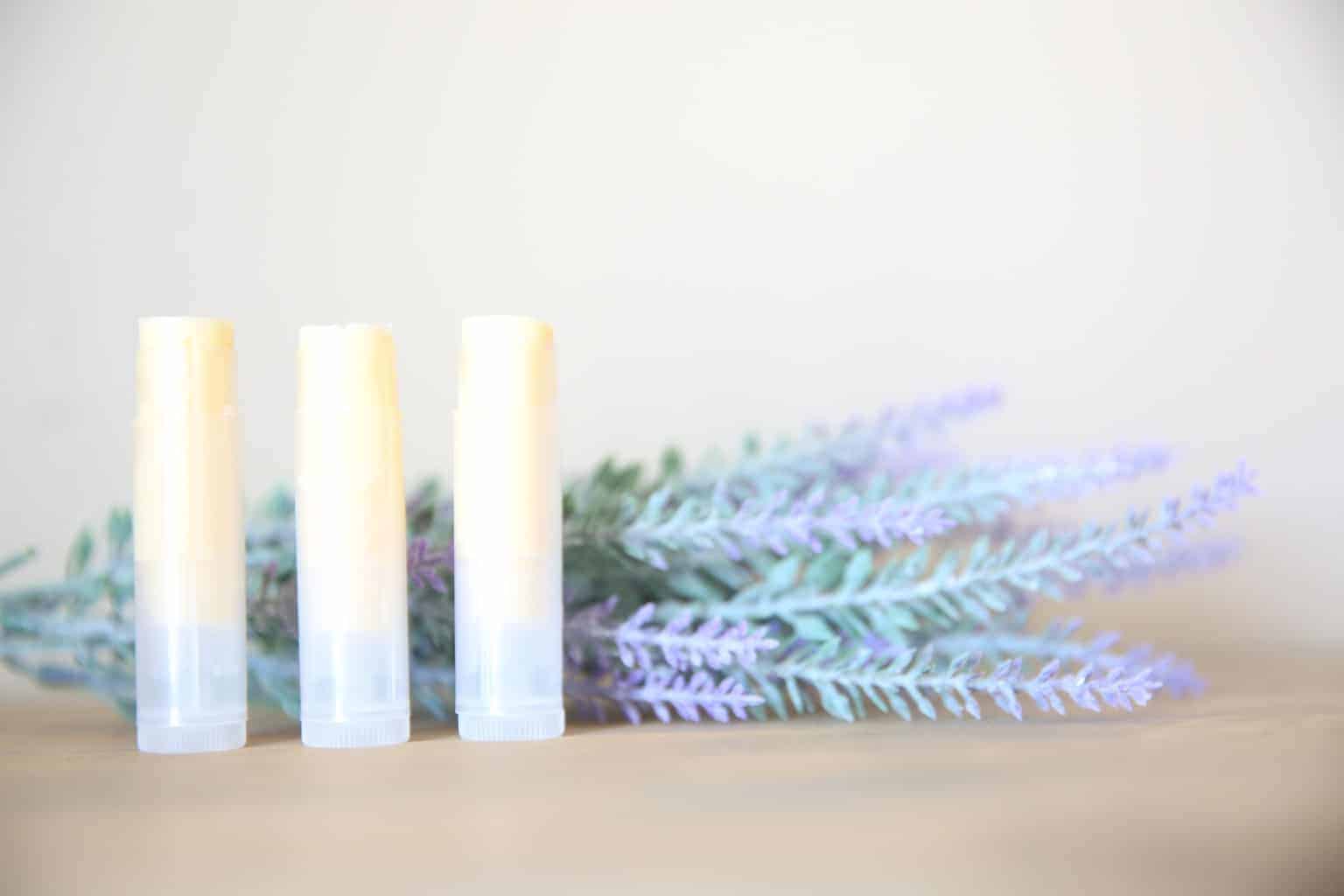
Why you will love this homemade lip balm
This homemade lip balm recipe is easy to whip up, very cheap, and made with all-natural ingredients.
As much as I try to keep toxic products out of my home, I try to make homemade products as sustainable and environmentally friendly as possible.
When making products, especially skincare products, it is so important to use all-natural ingredients.
Take this all-natural lip balm, for example; it is being applied to one of the most sensitive parts of the body!
It’s almost a guarantee some of it is making its way into the mouth, not to mention the fact that the skin is already naturally absorbent.
Your lip balm recipe questions
Will my lip balm need a preservative? No. These ingredients do not require the use of a preservative.
How long will this lip balm last? This recipe should last up to two years.
How should I store this lip balm recipe? Store your lip balm out of direct sunlight with the cap on.
OTHER DIY HOME PRODUCT RECIPES YOU MIGHT LIKE
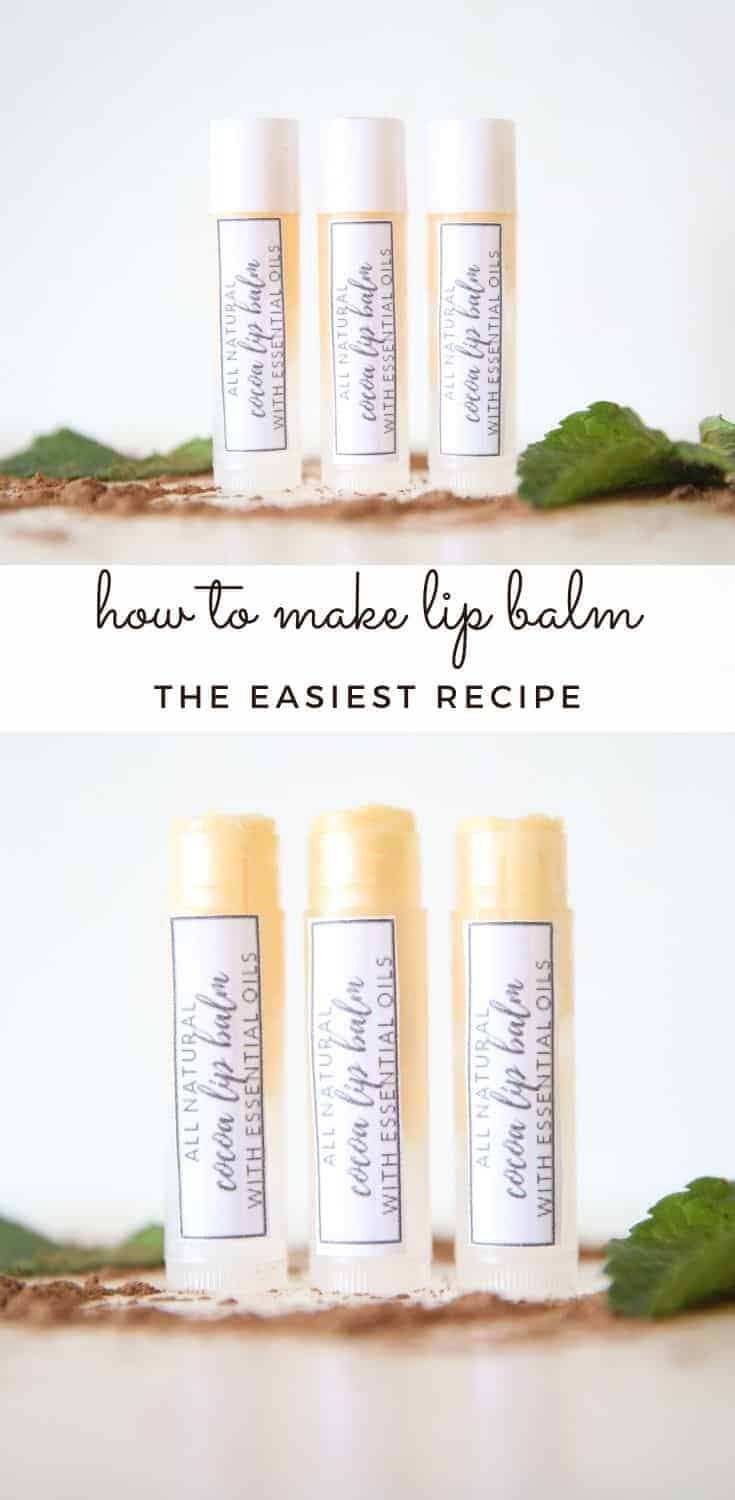
Have fun making your own lip balm, and be sure to let me know how it turns out in the comment section below!
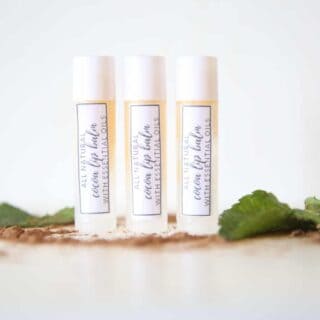
DIY Lip Balm with Essential Oils
Equipment
- Double Boiler
- Lip balm tubes or small metal tins
Ingredients
- 2 tablespoons beeswax
- 2 tablespoons cocoa butter
- 2 tablespoons coconut oil
- 10 drops peppermint essential oil optional
Instructions
- Melt all ingredients (except the essential oils) in a double boiler. If you don't have a double boiler, you can make one by putting a glass bowl over a pot of water and bringing it to a boil.
- Stir often until melted. Then, remove from heat and stir in the peppermint.
- Work quickly for this next step since the mixture will begin to harden. Fill lip balm containers using a small funnel, pipette, or old medicine dropper.
- Allow lip balm to cool and completely harden for several hours before capping off.

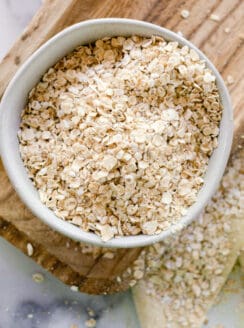
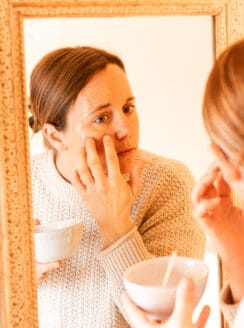
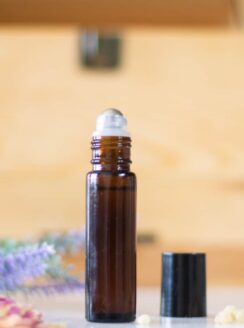
Phyllis Diane Atwood says
Hi. I ordered the cocoa butter for my lip balm from the link you gave. I made my lip balm but the odor from the cocoa butter was almost sickening. Is it supposed to smell like that?
Laura says
Hm, cocoa butter should have a natural chocolate like scent. Perhaps there was an issue with the packaging.
Esther says
Just wondering how much of each essential oil :Lavender and Rosemary: you would put in these lip balms? Thank you!!
Laura says
I would do 5 drops of each.
Julie Cunningham says
I will have to admit that in the past I would hit & miss on some of your DIY products, but recently my health has worsened & now am unable to work. Insomnia is getting worse and up usually 3-4 nights in a row. But my goodness! You are so amazing with all the products you have supplied to the public to better care for themselves & their families (including furbabies)! I am blown away! I’m sitting here going crazy trying to make sure I make a note to go back & check out certain ones, while I am printing off others. All I want to do is help people in their lives to feel better inside & out. I am into crystals & herbs as well, but anything natural is better than off any supermarket shelf. Thank you so much for all you do & all your hard work. I would love to learn as much as possible. Many blessings to you & yours.
Rebecca Dyck says
I tried this recipe since I live in a dry area and my skin has always been super dry. I wanted a lip balm or something that I didn’t have to re-apply every hour. But this recipe still seemed to dry out my lips. Even when they were wet from the balm , my lips burn like they do when they are very dry. And when I applied it, it melted on my lips so I constantly tasted it. I like it to be more of a coating that won’t wipe off easily. Do you have any suggestions on how to fix this? Also is coconut oil the problem? I’ve never had any moisturizing benefits from coconut oil. I tried it on my skin and hair and always felt even more dry. I would appreciate any suggestions on how to fix it.
Kayti says
Hii, do the essential oils not break down your plastic lip balm tubes? Since eo’s break down plastic, im worried to use any. thanks in advance!
Laura says
Certain thick, harder plastics are safe from essential oils breaking them down.
Lynn Walder says
Does this recipe work well for tins? Or should I order the tubes from Amazon?
I love your recipes! I have MCAS and struggle to find care products that I can use. Thank you for making these!!
Laura says
You can totally store them in a tin! I just use the tubes for easier application.
Tabby says
Probably an extremely dumb question, but do the essential oils need to be food grade?